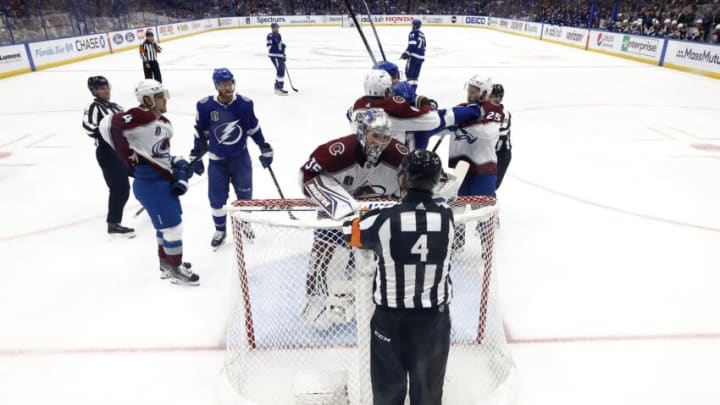The NHL could not have scripted it any better if they tried. Nazem Kadri scores the winner in overtime for the Colorado Avalanche in his first game back from injury.
Nobody knew where the puck was for a few seconds, giving us flashbacks back to Patrick Kane’s winner for the Chicago Blackhawks back in 2010.
After the Avalanche players left the ice in celebration and dejected Tampa Bay Lightning fans left Amalie Arena, an interesting development came out. At the time of Kadri’s game-winner, Colorado had six skaters on the ice.
Should the goal have counted? In that scenario, was it enough to take a “too many men on the ice” penalty?
The Avalanche had six skaters on the ice for Nazem Kadri’s overtime winner. It’s not as much a “penalty” or a missed call as you might think.
CityTv’s Breakfast Television had a nice segment featuring Julian McKenzie of the Athletic discussing the missed call. Interesting points were brought up on both sides. The NHL’s official score sheet said six players were on the ice for Colorado, a clear violation.
McKenzie concurred that it was during a line change and didn’t affect the play, so it’s not a bad call to let it slide. People commenting, who most certainly are armchair GMs turned armchair rules analysts, pointed out Tampa had more than five players on the ice as well.
Want to add a little more drama to this? A playoff goal with similar circumstances counted last year for Tampa Bay in a playoff game against the New York Islanders. Then Islanders coach Barry Trotz called out the excessive players on the ice with language that would make a sailor blush.
The first thing that we want to dive into was the fact the NHL said the score sheet, which had six Avalanche players listed on the ice, was based off of puck tracing technology. Puck tracking technology is still somewhat new, so maybe we shouldn’t consider it the end all be all.
Then again, the score sheet didn’t have excess Tampa players on the ice like commentators claimed the Lightning had.
Everyone’s favorite referee, Wes McCauley, was the referee for Wednesday night’s game. In a previous interview with TSN, McCauley said he learned from a note from his father to call three types of penalties: match penalties, scoring opportunities, and the “obvious foul that everyone sees”.
Colorado’s seventh man doesn’t seem to meet any of those three categories McCauley has built his career around calling.
Now here’s an old story about baseball umpires. Three umpires get together and decide to discuss umpiring. The first umpire says “I call it like I see it”. The second umpire says “I call it like it is”. The third umpire says “the call is nothing until I make it!”
What’s the point of that story time? Well, a penalty isn’t a penalty until it’s called a penalty. NHL referees miss calls all the time, but once they miss that call the infraction ceases to exist in the league’s eyes (unless player safety intervenes, of course).
So by that logic, there weren’t too many men on the ice, because a too many men on the ice penalty was not called, even if the scoresheet said seven players were on.
The NHL is sticking with the explanation that this was a judgment call of the refs. It was a huge moment in the Stanley Cup Final, but something every team seems to be guilty of every game, even if only for a few seconds. Next time the puck drops, referees will be extra careful counting.
